First month for free!
Get started
Published 9/26/2025
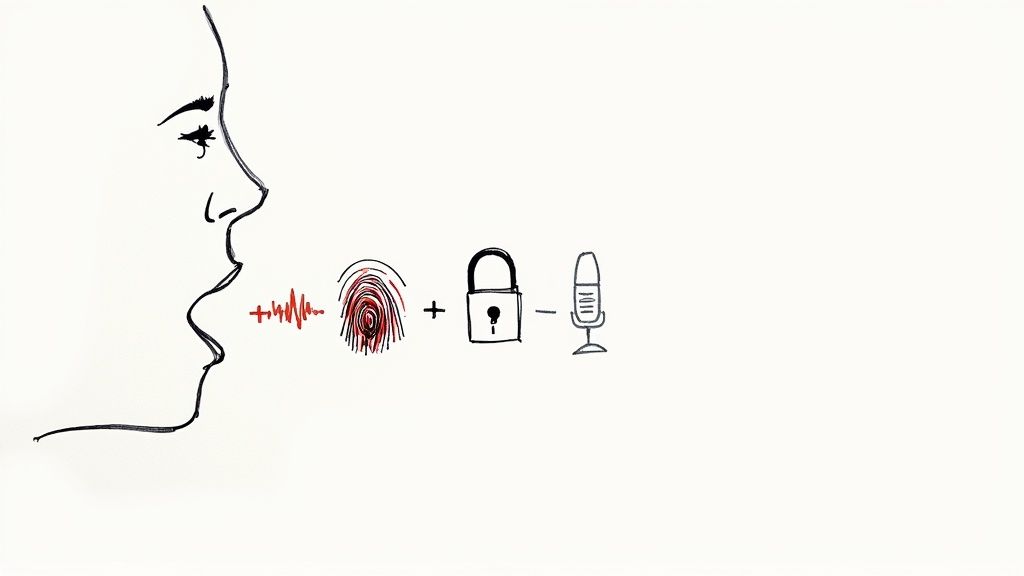
Ever found yourself locked out of an account, struggling to remember a password you set months ago? What if you could just… speak to log in? That’s the simple promise of voice biometrics.
This technology acts like a digital fingerprint for your voice. It doesn't just hear what you say; it analyzes how you say it, capturing the unique physical and behavioral qualities that make your voice one-of-a-kind.
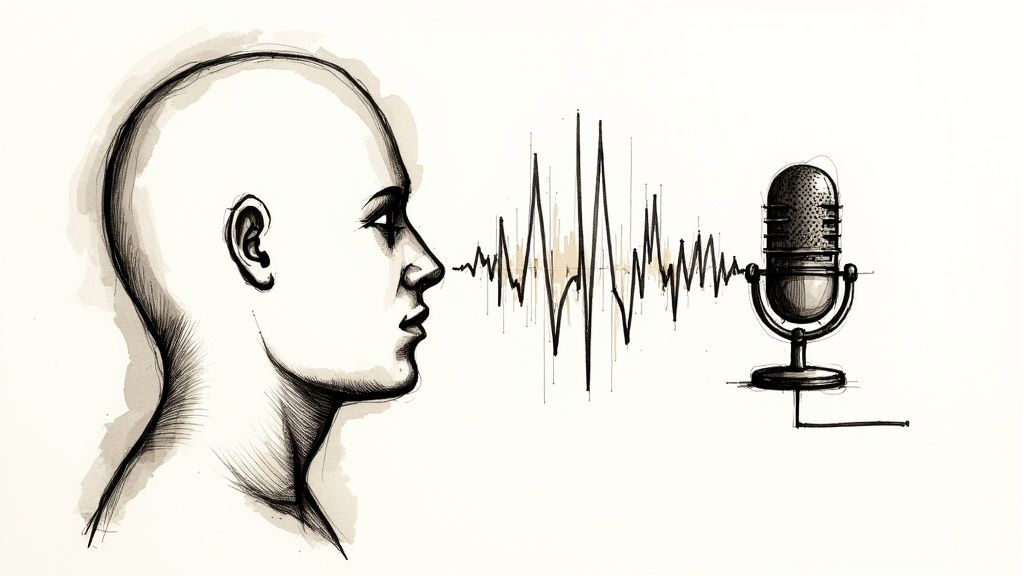
Think about it: no two voices are exactly alike. The unique shape of your vocal tract, mouth, and even your nasal passages creates a distinct sound. Add in your personal rhythm, pitch, and accent, and you have a complex acoustic signature that's incredibly difficult to fake.
Voice biometrics technology captures these subtle details and converts them into a secure digital template—your personal voiceprint.
This turns your voice into a powerful key for authentication. It’s far more intuitive than typing a password and adds a robust layer of security. Of course, it’s not always a standalone solution; it often works best as part of broader identity verification solutions to create multi-layered protection.
The numbers show just how quickly this idea is catching on. The global voice biometrics market was valued at USD 2.3 billion in 2024 and is expected to explode to USD 15.69 billion by 2032. This incredible growth makes sense when you consider that over 70% of organizations are already using biometrics to tighten security and make things easier for their customers.
Ever wondered how a system can recognize you just from the sound of your voice? It’s a fascinating process that turns your unique vocal patterns into a highly secure, digital key.
Think of it like a master chef who can instantly identify their signature dish by its unique blend of spices. Voice biometrics does the same thing, but with your speech. It’s not about the words you say, but the distinct way you say them.
The whole journey starts with a simple step called enrollment. You’ll be asked to provide a few voice samples by speaking a phrase or sentence. As you speak, the system gets to work analyzing over 100 different physical and behavioral characteristics that make your voice one-of-a-kind.
Next up is feature extraction. This is where sophisticated algorithms dig into the raw audio from your enrollment. They pinpoint a huge range of your unique vocal traits, including things like:
All this data is then converted into a secure, encrypted mathematical model we call a voiceprint. It’s crucial to understand that this isn't an audio recording of your voice. It’s a digital representation, which makes it incredibly secure and impossible to reverse-engineer.
The graphic below breaks down this three-step journey, from you speaking a simple phrase to having your identity confirmed.
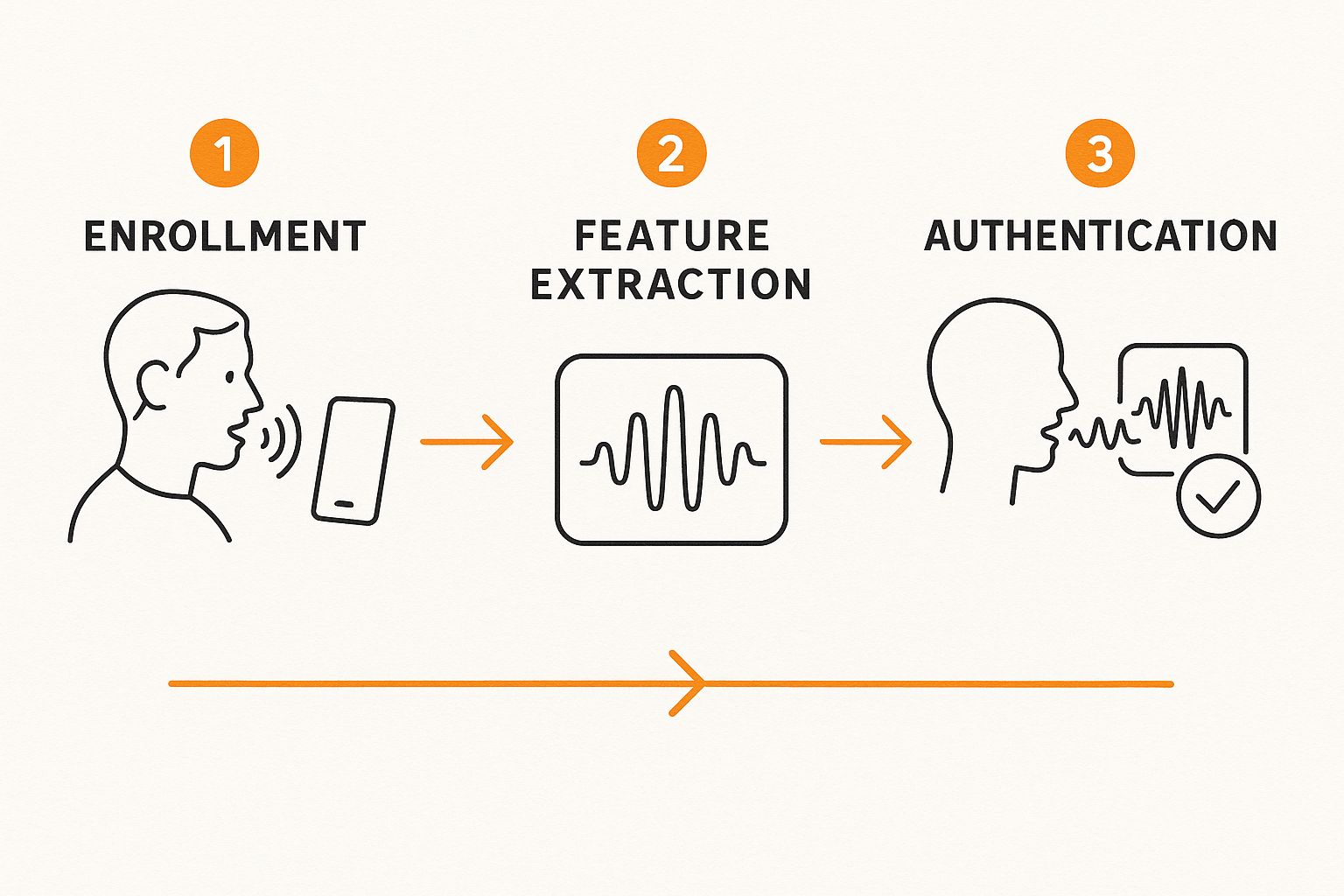
This straightforward process of enrollment, feature extraction, and authentication creates a security experience that’s both powerful and incredibly easy to use.
The real magic is in the pattern matching. When you call in later to verify your identity, the system compares your live speech against the voiceprint it has on file. If they match, you're in. If they don't, access is denied, stopping potential fraud in its tracks.
The advanced algorithms that make this possible are a specialized part of broader Artificial Intelligence Solutions.
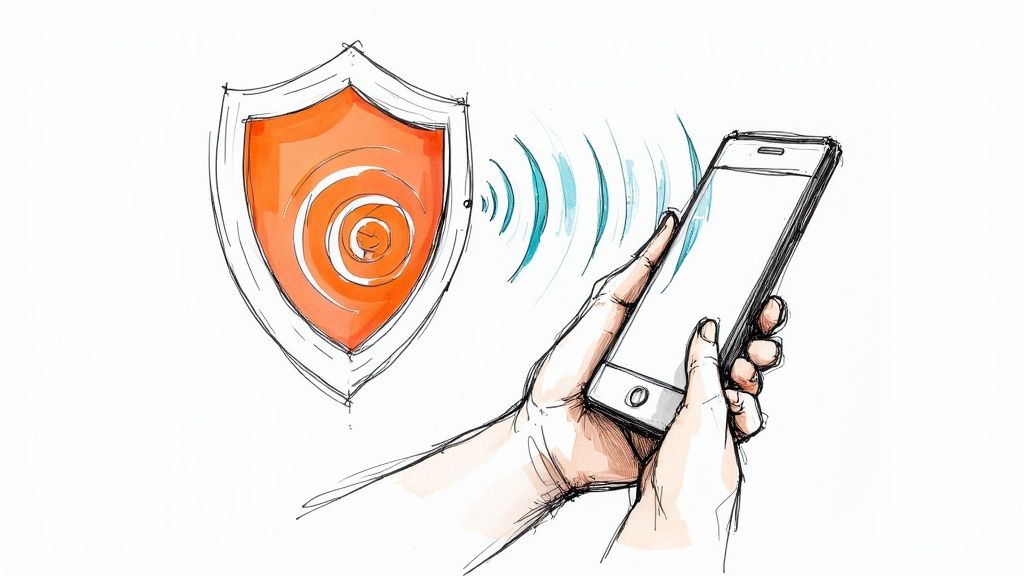
When it comes to using your voice for authentication, there isn't just one way to do it. The technology generally falls into two distinct categories: active and passive verification. Each has its own strengths and is designed for very different situations.
Think of active verification as a spoken password. This method, also known as text-dependent verification, requires you to say a specific, pre-determined phrase. You might be prompted with something like, "My voice is my password" or a unique series of numbers.
It's a very direct and intentional act of authentication. You know you're proving your identity at that exact moment. This makes it a great fit for high-stakes interactions where you need absolute certainty before proceeding, like authorizing a large wire transfer over the phone with your bank.
On the other side, we have passive verification, which is text-independent. This approach is much more subtle and works completely in the background during a normal conversation. There are no magic words to say.
The system simply listens as you speak naturally—for example, while you're explaining an issue to a customer service agent. It analyzes the unique characteristics of your voiceprint in real-time to confirm you are who you say you are, often without you even knowing it's happening.
Passive systems focus on how you say things, not what you say. They analyze the unique cadence, pitch, and rhythm of your natural speech, making the security process completely invisible to the user.
This creates a smooth, frictionless experience, which is why it's so popular in call centers. It gets rid of the need for those annoying security questions and gets customers the help they need faster.
So, when does it make sense to use one over the other? This side-by-side look at the two primary types of voice biometrics helps clarify where and why each is used.
| Feature | Active (Text-Dependent) | Passive (Text-Independent) |
|---|---|---|
| How It Works | You must say a specific passphrase. | Analyzes your natural conversation. |
| User Experience | A conscious, deliberate action is needed. | Seamless and completely invisible to the user. |
| Best For | High-security, single-step transactions. | Ongoing authentication in call centers. |
| Key Strength | Very high accuracy for a specific phrase. | An excellent, interruption-free user experience. |
Ultimately, the choice between active and passive verification comes down to balancing the need for explicit security with the desire for a great user experience.
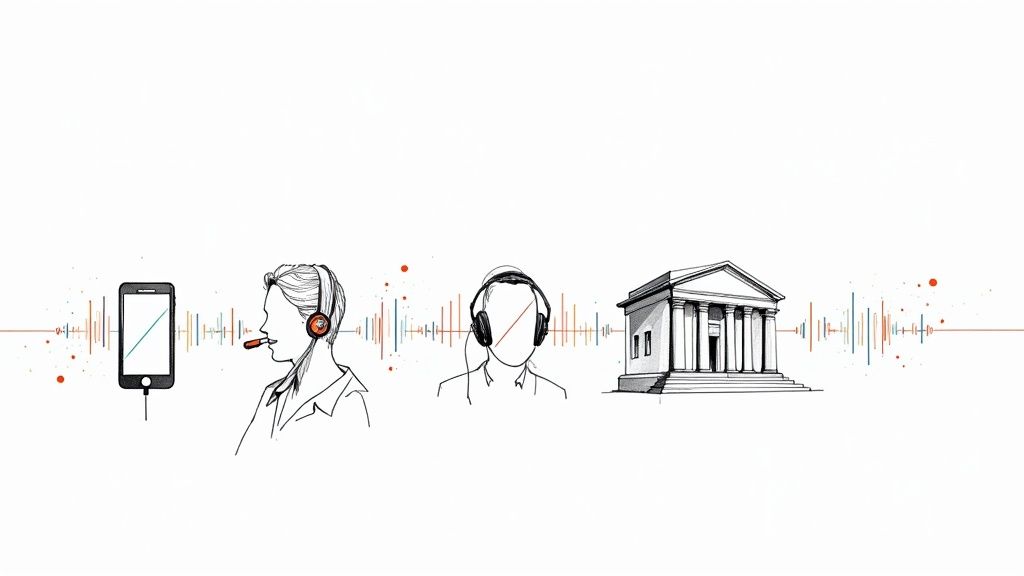
Voice biometrics isn't just a concept from a sci-fi movie anymore; it's a practical tool solving real problems across a surprising number of industries. You’ve probably already interacted with it without even realizing it. Companies are quietly weaving this technology into their daily operations to make things both more secure and a whole lot easier for customers.
The most common place you'll find it is in financial services, especially in contact centers. Instead of grilling you with a list of security questions when you call your bank, the system can confirm it's really you just from the sound of your voice. This small change makes a huge difference—it shortens call times and shuts down fraudsters trying to imitate you.
Banking is just the beginning. The applications for what voice biometrics can do are popping up all over the place, creating secure, hands-free ways to get things done.
Healthcare Security: Picture a busy nurse or doctor needing to access a patient's electronic health records (EHRs). With a quick voice command, they’re in. This keeps sensitive data locked down while helping them work more efficiently.
Corporate Access: Instead of fumbling for a keycard or trying to remember another complex password, employees can log into the company network or enter a secure area just by speaking. It’s simple and far more secure.
Retail and E-commerce: Some innovative retailers are testing out voice-based payments. You can approve a purchase with a spoken phrase, which is perfect for a smooth checkout experience on a smart speaker or your phone.
These examples really just scratch the surface, showing how flexible this technology is.
The core benefit in every scenario is the same: it replaces something you have (a card) or something you know (a password) with something you are—your unique voiceprint. This fundamental shift makes security feel natural and intuitive.
Many companies are now using passive voice biometrics, which verifies a caller's identity in the background during a normal conversation. It's a fantastic way to cut down on call handling times and make the whole experience better for the user. Industries like healthcare and the public sector are also getting on board, using it for everything from authenticating telehealth appointments to providing secure access to government services.
For a deeper dive into these trends, you can discover insights on the growing voice biometrics market on MordorIntelligence.com.
Here's the rewritten section, designed to sound completely human-written and natural.
So, what's behind the big push for voice biometrics? It’s not just about chasing the latest tech trend. It's a direct response to some very old, very real problems with security, customer frustration, and wasted time. Voice authentication brings a mix of benefits to the table that old-school methods just can't compete with.
First and foremost, it’s a massive security upgrade. Think about it: passwords get stolen, PINs are forgotten, and security questions can be answered by anyone who’s done a bit of social media snooping. Your voice, however, is uniquely yours.
Your voiceprint is built from over 100 different physical and behavioral traits. This creates an identifier so complex that it's incredibly tough for a fraudster to fake. It’s like having a key that can't be copied or lost.
Security is crucial, but what really makes voice authentication a game-changer is how much better it makes the customer experience. Let’s be honest, nobody likes trying to remember their password or getting grilled with a dozen security questions. Voice biometrics gets rid of all that friction. Customers just talk, and they’re in.
This seamless experience has a direct impact on how efficiently things run on the business side, especially in places like call centers. Automating the "who are you?" part of the conversation can trim precious seconds—or even minutes—off every single interaction.
One study showed that voice biometrics cut agent handling time by an average of 45 seconds per call. That might not sound like much, but when you scale it across thousands of calls a day, the cost savings are huge. Plus, your agents can stop playing security guard and get back to actually helping people.
When you put it all together—stronger security, a hassle-free experience for customers, and real, measurable gains in efficiency—it’s easy to see why so many organizations are turning to voice biometrics. It’s one of those rare solutions that makes life safer for the business and simpler for the customer, all at the same time.
It’s smart to be skeptical about any security technology. Before you trust something with your identity, you need to know it can handle real-world curveballs. Let's dig into some of the most common questions people have about voice biometrics.
This is probably the first question that pops into everyone's head. The short answer is: it’s highly unlikely. Modern systems are built specifically to defeat this kind of attack using something called "liveness detection."
Think of it as the system’s ability to tell the difference between you talking right now and a recording of you from yesterday. It analyzes tiny, almost imperceptible acoustic details, background noise shifts, and the natural, fluid variations in live human speech. A simple playback just doesn't have those markers, making it incredibly difficult for a fraudster to spoof their way in.
We've all been there—you wake up with a scratchy throat and sound completely different. It’s natural to worry this might lock you out. But voice biometrics is surprisingly robust.
The system isn't just listening to how you sound; it's analyzing the underlying physical structure of your vocal tract. It measures over 100 different vocal characteristics, and most of these are permanent physical traits that don't change when you're sick. While a serious case of laryngitis could be a problem, most systems have a backup plan, like a one-time passcode, for those rare instances.
The system focuses on the unique, underlying structure of your voice—not just the surface sound. Think of it like a facial recognition system that can still identify you even if you're wearing a new pair of glasses. The fundamental features remain the same.
Absolutely. Privacy is at the core of how this technology is designed. A huge misconception is that the system is storing a .mp3 file of you saying "my voice is my password." That's not how it works at all.
Your voiceprint isn't an audio file. It’s a digital representation of your voice, converted into a heavily encrypted string of numbers and characters. This mathematical model is secure for two key reasons:
This two-pronged approach ensures your identity stays yours and yours alone.
Ready to integrate fast, secure, and affordable transcription into your application? Lemonfox.ai offers a developer-friendly Speech-to-Text API that processes audio with exceptional accuracy. Start your free trial today and get 30 hours of transcription on us.